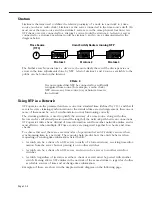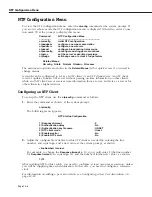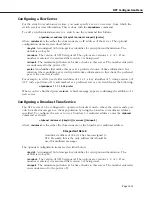
NTP Configuration Menu
Page 12-13
Configuring a New Server
For the switch to synchronize its time, you must specify a server, or servers, from which the
switch receives time information. This is done with the
ntpaddserv
command.
To add a synchronization server to a switch, use the command that follows:
ntpaddserv <address> [<keyId><version><minpol>] [prefer]
where
<address>
is the either the domain name or IP address of the server. The optional
configuration items are described below:
<keyId>
. An unsigned 32-bit integer key identifier for encryption authentication. The
default is no key
ID
.
<version>.
The version of
NTP
being used. The options are versions 1, 2, or 3. If no
number is entered, it is assumed that version 3 is being used.
<minpol>
. The minimum poll interval for time checks to this server. The number entered is
seconds raised to the power of 2.
prefer
. An identifier that marks this peer as a preferred source of time information. In a
situation where multiple peers could provide time information to this client, the preferred
peer is the one that is used.
For example, to add a peer with an address of 1.1.1.1, a key identifier of 5, using version 3 of
NTP
, with a poll time of 16, and marked as a preferred server, you would enter the following:
ntpaddpeer 1.1.1.1 5 3 4 prefer
When you have finished press
<return>
. A brief message appears confirming the addition of a
new server.
Configuring a Broadcast Time Service
The
NTP
server can be configured to operate in broadcast mode, where the server sends peri-
odic broadcast messages to a client population by using the broadcast or multicast address
specified. To configure the server to use a broadcast or multicast address, enter the
ntpbcast
command as shown:
ntpbcast <address> [<keyId>] [<version>] [<minpol>]
where
<address>
is the either the domain name or the broadcast or multicast address.
♦
Important Note
♦
A multicast address of 224.0.1.1 has been assigned to
NTP
. Presently, this is the only address that should be
used for multicast messages.
The optional configuration items are described below:
<keyId>
. An unsigned 32-bit integer key identifier for encryption authentication. The
default is no key
ID
.
<version>.
The version of
NTP
being used. The options are versions 1, 2, or 3. If no
number is entered, it is assumed that version 3 is being used.
<minpol>
. The minimum poll interval for time checks to this server. The number entered is
in seconds raised to the power of 2.
Summary of Contents for Omni Switch/Router
Page 1: ...Part No 060166 10 Rev C March 2005 Omni Switch Router User Manual Release 4 5 www alcatel com ...
Page 4: ...page iv ...
Page 110: ...WAN Modules Page 3 40 ...
Page 156: ...UI Table Filtering Using Search and Filter Commands Page 4 46 ...
Page 164: ...Using ZMODEM Page 5 8 ...
Page 186: ...Displaying and Setting the Swap State Page 6 22 ...
Page 202: ...Creating a New File System Page 7 16 ...
Page 270: ...Displaying Secure Access Entries in the MPM Log Page 10 14 ...
Page 430: ...OmniChannel Page 15 16 ...
Page 496: ...Configuring Source Route to Transparent Bridging Page 17 48 ...
Page 542: ...Dissimilar LAN Switching Capabilities Page 18 46 ...
Page 646: ...Application Example DHCP Policies Page 20 30 ...
Page 660: ...GMAP Page 21 14 ...
Page 710: ...Viewing the Virtual Interface of Multicast VLANs Page 23 16 ...
Page 722: ...Application Example 5 Page 24 12 ...
Page 788: ...Viewing UDP Relay Statistics Page 26 24 ...
Page 872: ...The WAN Port Software Menu Page 28 46 ...
Page 960: ...Deleting a PPP Entity Page 30 22 ...
Page 978: ...Displaying Link Status Page 31 18 ...
Page 988: ...Displaying ISDN Configuration Entry Status Page 32 10 ...
Page 1024: ...Backup Services Commands Page 34 14 ...
Page 1062: ...Diagnostic Test Cable Schematics Page 36 24 ...
Page 1072: ...Configuring a Switch with an MPX Page A 10 ...
Page 1086: ...Page B 14 ...
Page 1100: ...Page I 14 Index ...






























